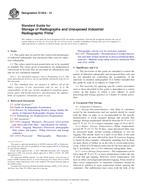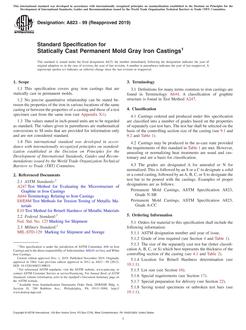1.1 These test methods cover the determination of the weight per unit area of waterside deposits on heat-transfer surfaces of steam generator tubes. The following test methods are included:
| Sections | |
| Test Method A–Mechanical removal by scraper or vibrating tool-removed deposit weight method | 7 to 16 |
| Test Method B–Chemical removal by solvent-tube weight loss method | 17 to 27 |
| Test Method C–Mechanical removal by glass-bead blasting-tube weight loss method | 28 to 37 |
1.2 Test Method A is a procedure applicable to deposits ranging from 16 to 76 g/ft². This method allows the discretionary selection of the area on the tube to be sampled. The removed deposit allows for further chemical analysis.
1.3 Test Method B is a method applicable to deposits ranging from 28 to 73 g/ft². The method averages out the heavier and lighter deposited areas. The solvent solution produced allows for further chemical analysis.
1.4 Test Method C is a procedure applicable to deposits ranging from 17 to 88 g/ft². The method averages out the heavier and lighter deposited areas. The removed deposit does not allow for further chemical analysis.
1.5 These test methods have been generally evaluated on the types of waterside deposits generally found on heat-transfer surfaces of steam generator tubes. It is the user's responsibility to ensure the validity of these test methods for other types of deposits or high temperature scale.
1.6 These methods are sometimes used for accumulated deposition in rifled steam generator tubes. Experience has shown that there is a significant difference in the deposition in the grooves and on the lands on some rifled steam generator tubes. The grooves have been shown to hold more deposit. Test Method B and Test Method C will average out this difference. In Method A the choice exists, either to choose to remove the deposition from the groove if it is visually determined to be more heavily deposited, or to remove equally over the grooves and lands. It is important that it be understood what choices were made and that the report reflect the choices made when using Test Method A on rifled steam generator tubes.
1.7 There are some steam generator tubes where it is apparent that half of the tube is exposed to the flame from the external appearance, this side is typically called the fireside or hot side. The other half of the tube is not exposed to the flame from the external appearance is typically called the casing side or cold side. These test methods also require that the tube be split in half, so the tube is generally split along these lines. On these tubes it is generally found that more internal deposition exists on the fireside or hot side. Some users of these methods will determine the deposition only on side where it appears visually that more deposition exists. Some users will determine the deposition on both sides and report the results separately and some will average the two results. It is important that the user of the data be aware of the choices made and that the report of the results be specific.
1.8 The values stated in either SI or inch-pound units are to be regarded as the standard. The values given in parentheses are for information only.
1.9 This standard does not purport to address the safety concerns, if any, associated with its use. It is the responsibility of the user of this standard to establish appropriate safety and health practices and determine the applicability of regulatory limitations prior to use.
7.1 This test method covers the determination of accumulated deposition in a steam generator tube by the mechanical removal of the deposit by scraper or vibrating tool, the collection and weighing of the dry deposit. This collected deposit is then available for further chemical analysis, if desired. The method also allows for discretionary removal of the deposit from the tube in areas of the most interest.
17.1 This test method covers the determination of accumulated deposition in a steam generator tube by chemical removal of the deposit and measuring the weight change in the deposit. This solvent containing the deposit is then available for further chemical analysis, if desired. The method does not allow for discretionary removal of the deposit from the tube in areas of the most interest.
28.1 This test method covers the determination of accumulated deposition in a steam generator tube by the mechanical removal of the deposit by glass-bead blasting. The method does not provide a sample of the deposit suitable for chemical analysis after the removal process. The method does not allow for discretion in selecting the area to be cleaned.
Product Details
- Published:
- 05/01/2009
- Number of Pages:
- 7
- File Size:
- 1 file , 140 KB
- Redline File Size:
- 2 files , 330 KB


